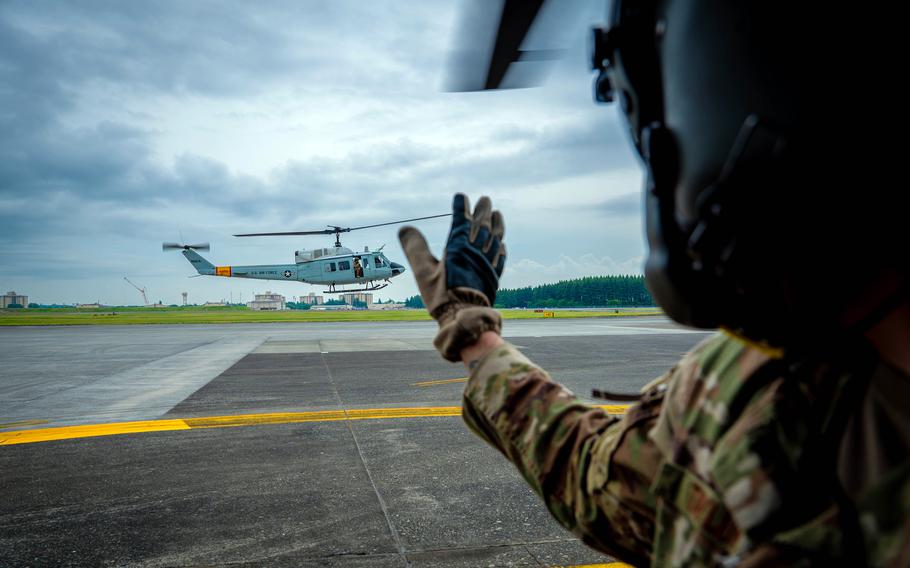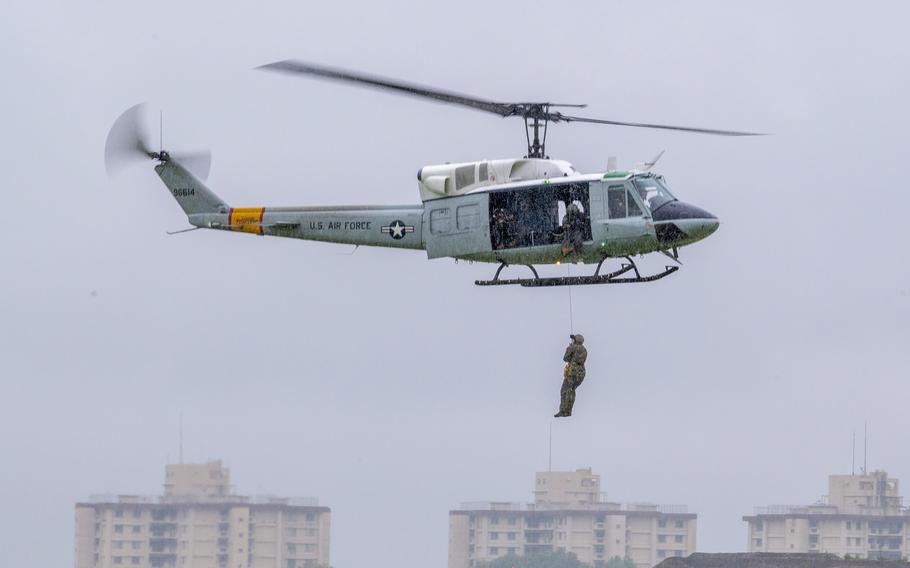
Tech. Sgt. Christopher Taylor, a 459th Airlift Squadron special mission aviator, waves as a UH-1N Huey takes off for a formation flight at Yokota Air Base, Japan, on May 9, 2025. (Alexzandra Gracey/U.S. Air Force)
YOKOTA AIR BASE, Japan — The distinctive “whomp, whomp” of UH-1N Huey helicopters is set to fade from the skies over western Tokyo as the Air Force prepares to retire the aircraft after more than six decades of service.
A banner displayed during Yokota’s recent Japanese-American Friendship Festival marked the moment: “SEEEYUH! 1980-2025. USAF Yokota AB UH-1N Huey.”
The sign, featuring images of the helicopters and the 459th Airlift Squadron’s centaur logo, signaled the end of the Huey era to approximately 117,000 festivalgoers at the annual flightline event.
The squadron, based at Yokota, operates a small fleet of UH-1Ns and C-12J Huron aircraft. The Hueys support a range of missions, including flying VIPs across U.S. military installations around Tokyo, airlifting patients to the hospital at Yokosuka Naval Base south of Yokohama, and providing search and rescue or operational support.
“After 61 years of service, the UH-1N Huey fleet is set to retire,” a spokesman for Yokota’s 374th Airlift Wing, Master Sgt. Nathan Allen, said in an email Thursday.

Airmen from the 459th Airlift Squadron show off the capabilities of the UH-1N Huey during the Japanese-American Friendship Festival at Yokota Air Base, Japan, on May 17, 2025. (Jarrett Smith/U.S. Air Force)
Allen and Pacific Air Forces officials did not respond to additional questions emailed Thursday and Friday about the timing of the Hueys’ departure or their replacements.
Photos posted on Yokota’s official website show two UH-1Ns flying in formation over Japan on May 9. One image shows a Huey flying past the Tokyo Skytree, a 2,080-foot broadcasting tower with observation decks.
The first Hueys at Yokota — UH-1P models — arrived in 1971 and were later replaced by the twin-engine UH-1N variant, according to the wing’s website.
The UH-1 series, developed by Bell Helicopter in the 1950s and widely used during the Vietnam War, became a symbol of U.S. military aviation. Known for its unique rotor sound and battlefield versatility, the Huey was used by the Army for medical evacuations, troop transports and combat air support.
The Huey has flown more combat hours than any other aircraft in history, according to a 2011 release from the Joint Multinational Readiness Center in Germany, issued when the Army retired its remaining Hueys in the country.
The Air Force plans to replace its UH-1Ns with Boeing’s MH-139A Grey Wolf. That helicopter, based on the commercial AW139, offers improved performance — cruising 50% faster, flying 50% farther and lifting 5,000 more pounds than the Huey, while offering a 30% larger cabin, according to the service’s website.
However, the Air Force last year reduced its planned purchase of the Grey Wolf from 74 to 42 aircraft, according to budget documents cited in a March 2024 report by defense publisher Janes.